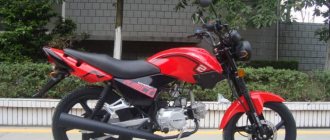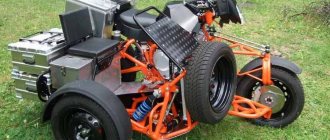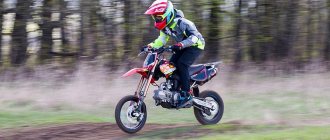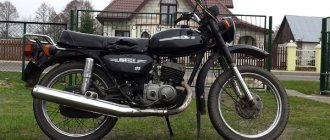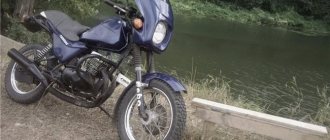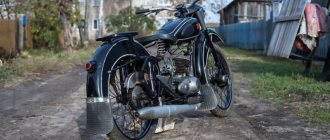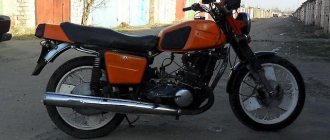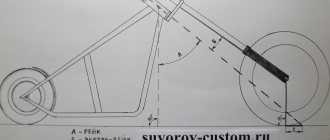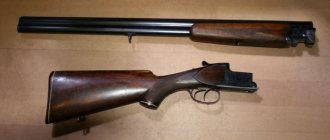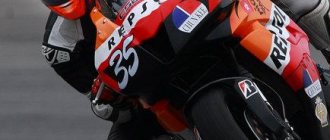L-300 "Red October". The very first.
The very first serial Soviet motorcycle was the L-300 “Red October”. the first motorcycle of the USSR At the beginning of 1930, Leningrad designers prepared its drawings, inspired by the most reliable bike of that time - the German DKW Luxus 300. And already in the fall of the same year the first batch of L-300 was ready. The motorcycle was produced until 1938, and then the no less legendary IZH-8 was created on its basis. This “descendant” of the L-300 even ended up on silver coins... in New Zealand. By the way, the name IZH-7 was borne by the same L-300s, which were produced in Izhevsk in parallel with the Leningrad enterprise “Red October”.
History of the creation of motorcycles in the USSR
Previously, the Soviet motorcycle was considered a real symbol of good feelings and joy, because it was used for various purposes - riding girls, visiting a maternity hospital, transporting potatoes from the field, riding with friends, and so on. Current motorcycles in Russia and other countries were created by well-known foreign companies, but do not forget about the legends of past years, which even today in some ways are superior to certain new products.
The history of world motorcycle technology begins in 1902, when the famous engineer Leitner decided to install a 430 cc engine on a bicycle. The maximum speed then did not exceed 35 km/h. Until 1923, the Soviet motorcycle fleet consisted of only foreign models, but after that engineer Lvov decided to create the first Soyuz motorcycle. A couple of years later, namely in 1928, a more famous motorcycle called Izh was mass-produced. Every year, Soviet motorcycles improved, but in some characteristics they were inconvenient or inferior to foreign models. The then IZH models of the 20s had a quite good engine, which reached a volume of 1,200 cubic meters. cm and produced a power of 25 horses. Even its heavy weight of 290 kg did not prevent it from accelerating well and feeling great on the road.
But over time, new models appeared that won millions of hearts. The best of them were designed and produced at the Izhevsk, Minsk, Kiev and Kovrov factories. We offer several of the most famous and first motorcycle models of the USSR, which are still known today.
One of the very first production motorcycles, which was produced since 1930. Unfortunately, this is not a proprietary development of the USSR; the German DKW Luxus 300 was taken as the basis. Unfortunately, the production of the model lasted only 8 years, but enough copies were produced. Subsequently, the model was used on such a motorcycle as the Izh-8.
The technical data of the L-300 were impressive for that time. The engine had a volume of 300 cubic meters and up to 3,000 rpm. The power was only 6 horsepower, and the maximum speed was limited to 80 km/h. With a light weight of only 125 kg, motorcycles could consume an average of 4.5 liters per hundred. The motorcycle was produced at the Red October enterprise.
Zid-50 Pilot
Zid-50 Pilot
– a sports road model designed for business trips, tourist trips and walks. It has high technical parameters, fuel efficiency and comfort. The mokika uses a two-stroke, carburetor engine with a crank-chamber purge and a plate valve at the inlet. The electronic ignition system ensures easy engine starting and uninterrupted spark generation in any range of operation. Hydraulic shock absorbers of the front fork and rear suspension ensure a smooth ride when operating the mokika in any road conditions.
Basics and tuning options
The “King of the Road,” as fans call it, can be converted into either a sport or a classic (chopper). The last option is the most popular, because it better suits the characteristics of the motorcycle.
A distinctive feature of choppers is the elongated frame , with which do-it-yourself tuning of the Dnieper begins. After welding, the frames are usually sandblasted until they are completely shiny. When the pendulum is lengthened, the rear wheel moves back 7-10 cm, and the front fork is lengthened no more than 15 cm from the standard version. The inclination of the latter is selected based on considerations of convenience and safety. Lengthening the pendulum can be done in a tuning workshop, for example here, or you can do it yourself using video instructions.
If possible, shock absorbers are replaced with lighter, chrome-plated ones. The fenders and their fastenings, side support, driver's footrests, kick starter and headlight are also chrome-plated. The engine is polished until it fully matches the chrome elements.
Tuning the exhaust system is often achieved by installing nickel-plated elbows and forward flow systems. Such an innovation, firstly, will complement the attractiveness of the appearance, secondly, it will improve (albeit not significantly) the performance of the engine, and thirdly, it will give the engine sound a dense, bassy tone.
Tuning a Dnepr motorcycle also involves installing the following modules:
- The tachometer gives the bike a more “serious” look and gives its owner ease of operation.
- The starter modernizes the unit and adds practicality to it.
- Fifth gear - a new 5-speed gearbox, or replacing reverse gear with a new speed, together with a new gearbox, can raise the speed limit by a couple of tens of km/h.
Increasing the bike's speed limit is also achieved by lightening its structural components. For example, a gas tank from a Honda rebel 250, which will also complement the classic “road monster” style.
Imported equipment
Czech motorcycles in the Soviet Union were considered top technology, accessible only to the lucky few. While it was still possible to buy ordinary Izhi with Voskhod, even if they cost a lot, Java and CZ were incredibly difficult to get. Those who wanted to own them were not stopped even by problems with spare parts, which had to be ordered through special stores, since all imported parts were supplied from Czechoslovakia, which was socialist at that time. Now these brands no longer exist de facto, although Chinese motorcycles under the Jawa brand are sold in some countries. This is not the same at all - the best motorcycles of that era left with the USSR. Nowadays, antique Javas are in demand mainly among enthusiasts who would be happy to include them in their collection of retro equipment. Old USSR motorcycles in good technical condition are not easy to find now, but it is worth it if you are partial to such bikes.
Belgian masterpiece
Two people worked on this model, one of whom was Belgian. One evening he walked into a local bar, in the parking lot of which there was an old Dnepr. That’s how he came up with the idea of restoring a Soviet bike.
The repair process and tuning took more than two months. Although it was initially planned to restore the motorcycle in the rat-custom style, in the end the old Dnepr combines several styles: scrambler, chopper and tracker.
For a more believable effect, the specialist used special paint to give the surface a rusty effect. The Belgian enthusiast added several parts from the famous Harley-Davidson to the Soviet bike: a custom steering wheel, a leather saddle and a brake light.
The master also equipped the engine with new Schaeffler bearings and pistons from the BMW R60, and the wheels were finished with shiny tires from Heidenau K37. Now the old “Dnepr” from 1970 has found a second wind and is ready to conquer new tracks.
Izh planet sport
The road “IZH Planet” (IZH 7.107) belongs to the middle class motorcycles and is intended for use on roads with different surfaces. The IZH Planet can be used with a side passenger or cargo trailer and a universal cargo module. Wide transmission chain from the crankshaft to the clutch, multi-disc ( seven pairs of clutches with reinforced drive disc splines and a cam release mechanism ensure durability and reduce the clutch release force. The increased volume of the Izh Planet air cleaner, complete with vibration dampers for the cylinder fins, reduces the noise level of the motorcycle and fatigue of the driver and passenger.
Dnepr 11
And this model of Soviet motorcycles, although universal in design and operation, was in greatest demand among “rockers.” The first Soviet bikers considered the Dnepr 11 one of the best; the motorcycle was produced in Kyiv.
The design of the motorcycle is simple and easy to repair; most also tried to tune the model, which was quite possible with little effort. An interesting fact is that Soviet Dnepr 11 motorcycles can still be found on the roads in working condition.
Mopeds and scooters
The list would be incomplete without Soviet mopeds such as “Karpaty” and “Riga”. Their first modifications were equipped with bicycle pedals, and were the most inexpensive form of transport, which was very popular in rural areas. And the Tula plant produced motor scooters “Tula”, “Tourist”, “Tulitsa” and a cargo “Ant” with a luggage platform and wide car wheels at the rear. The latter is generally in demand even now, despite the fact that it was discontinued a long time ago. Mopeds in the USSR became so popular mainly due to their low price and the absence of the need to obtain a driver’s license to drive them. They were usually the first motorcycles in the hands of future bikers, instilling in them a love of two wheels. The Carpathian moped was a dream for many of them, especially since it was already completely legal to ride a moped from the age of 14.
Belarusian “masterpiece” – Minsk 125 Sport
The global market for sports motorcycles is simply huge and we are accustomed to the fact that only foreign companies “rule the show” on it. But, absolutely and undeservedly, we have forgotten about our domestic producers. In this article I will talk about one of the models of domestic sports motorcycles, namely the Minsk 125 Sport motorcycle. This motorcycle simply amazes with its bold, advanced and very beautiful design and, at first, it seems that this is not our “masterpiece” , and some leading foreign one - this is our car, and this is evidenced by the proud inscription on the fairing - “Minsk”. Its appearance became possible thanks to the very close cooperation of our Minsk bicycle and motorcycle plant and the very famous British company MEGELLI, which is widely known today in Belarus. By and large, the Minsk 125 Sport motorcycle is a British sportbike Megelli 125 R, released in 2007.
M-62. Choice of police.
The Soviet police, fair and incorruptible, in the 50s-60s mostly traveled on motorcycles with sidecars.
The M-62, produced by the Irbit Motorcycle Plant, was the most popular choice of servants of the law. Its four-stroke engine produced 28 hp. An interesting fact is that ordinary citizens of the USSR were not allowed to operate Urals without a sidecar at that time. Still, these motorcycles were quite difficult to control. But the police used motorcycles without sidecars, which looked very cool in the eyes of Soviet boys. How can you not want to become a policeman!
External tuning of the Dnepr motorcycle
As for external tuning, everything here can only be limited by your imagination, but before you do anything, look first at the Dnepr tuning photo, where you can see some modernization options. If you change the technical characteristics of the MT Dnepr, then this will significantly improve its appearance, because this model was initially limited to external features and some kind of plastic. An excellent option for external tuning would be to install additional indicators, an improved tachometer and speedometer on the motorcycle.
Most tuned motorcycles come in the form of choppers or sports versions, so to get a chopper from the Dnepr you will have to install an extended front fork. And to make your iron horse look like a chopper, it is recommended to install a disc brake system, which will also give the motorcycle an excellent appearance. Many specialists in the modernization of Soviet technology advise carrying out a procedure to lighten the entire structure of the Dnieper. To do this you will have to replace:
- shock absorbers;
- shields;
- fuel tank: seat;
- footrests;
- headlight;
- steering wheel.
As a result, after replacing the above parts with lighter ones, you will get many positive aspects. Thus, the motorcycle will be easy to control, maneuverable, and speed indicators will be noticeably increased. Also, if you notice other heavy components or parts, if possible, replace them with lightweight analogues.
But even this is not the end of the external tuning of the Dnieper, because one of the standard methods is to coat parts with chrome. Unfortunately, this procedure is quite expensive, so experts have come up with an excellent alternative - the necessary part is coated with nickel.
In 1958, the Kharkov bicycle factory began producing the B-901 bicycle specifically for the D-4 engine.
Compared to a regular road machine, this bike had a shock absorber in the front fork and larger tires. Apparently, the B-901 can be considered the first Soviet mass-produced motorbike. Then the production of motorbikes was transferred to the Lvov Metal Plant (since 1960, Lviv Motorcycle Plant - LMZ). In the same year, the plant began producing B-902 motorbikes, which differed from the B-901 mainly in the frame design.
In 1962, the plant’s design bureau created the MV-042 “Lvovyanka” motorbike. It was a fundamentally new model with a special load-bearing all-stamped frame, telescopic front fork and even spring-loaded rear suspension.
In the first batches of the Lvovyanka, the engine was still the same - D-4. In the process of subsequent modernization of the moped, instead of a rear fork with a central spring, they began to install double shock absorbers in aluminum casings. And, most importantly, the D-4 was replaced by a new engine - the D-5, with the compression ratio increased to 6 units. Engine power increased to 1.2 hp. at 4500 rpm, fuel consumption remained at 1.5 l/100km.
The high thermal stress of the D-5 forced the designers to use a new cylinder with developed ribs and a removable head.
The “Lvovyanka” was replaced by the light moped “MV-044”, characterized by a developed hood and angular shapes.
In 1969, they began to produce a new model - “MP-045” with a reinforced frame and a larger gas tank.
The last of the light mopeds produced by the Lviv Motorcycle Plant is “MP-047” “Tisa”. After this model, the plant completely switched to the production of heavy mopeds - “Verkhovyna”, and subsequently “Karpaty”.
It should be noted that rear shock absorbers were installed on all light mopeds of the Lvov plant. Light mopeds from other Soviet factories, as well as most foreign light mopeds of those years, did not have such “luxury”.
Almost simultaneously with the plant in Lvov, the production of light mopeds was launched at the Riga motorcycle plant “Sarkana Zvaigzne” (“Red Star”) and at the Penza Bicycle Plant named after M.V. Frunze.
The running gear of the first light moped, the production of which began in Riga in 1959, was the Riga-16 men's bicycle manufactured here.
The familiar D-4 engine was installed on the bike. (A. Popov, Cooled Star, “Moto”, No. 1, 2012, p. 88). The resulting design was very reminiscent of the B-901 motorbike from the Kharkov bicycle factory.
Brutal design
In this model, the author decided to give a brutal look to the old bike, using mainly Soviet-made parts. He decided to emphasize the metallic essence of the motorcycle. To do this, he used several alloys: iron, aluminum, chromium.
The engine, rear wheel and steering wheel remained from the Dnepr 11. The fork, tank and front wheel were taken from IZH. Tractor Belarus was happy to provide a headlight and fitting for the bike.
In addition, the master himself built a fiberglass saddle. The taillight and oil pressure gauge came from the Zil-164 motorcycle.
Every detail has been repaired, painted or adjusted. As a result, the bike came out so powerful that it could compete with Harley himself.
Tula-200. For hunters and fishermen.
The Soviet motorcycle industry did not produce ATVs (some small-scale models, however, were still produced, read below), but for the needs of hunters and fishermen, a very unusual Tula-200 motorcycle with wide off-road wheels was produced. The mass distribution of such motorcycles occurred in 1986-1988.
The engine was taken from the Tulitsa motor scooter, increasing its power to 13 hp. This made it possible to accelerate at 200k to 90 km/h. 10-12 thousand of these bikes were produced per year, the last of which rolled off the plant’s assembly line in 1996. By the way, they even produced a trike based on the Tula-200!
"Sunrise"
Voskhod motorcycles began to be produced in the city of Kovrov, in the Vladimir region, in 1957. These were very unpretentious single-cylinder motorcycles (173.7 cm3 engine). The Dyagterev plant constantly improved this model, releasing onto the market, following the Voskhod, its modernized versions, such as Voskhod-2, Voskhod-3, Voskhod-3M. The latest Voskhod motorcycle was the 3M-01 model with a 15 hp engine. Because of their reliability, Voskhod motorcycles became real workers in thousands of Soviet villages. To this day, you can easily find a Voskhod motorcycle in good condition there.
"Izh-49"
In 1951, production of the Izh-49 model was launched in Izhevsk. As in the case of “Moskva,” they took a captured vehicle as a basis. True, the DKW NZ 350 has undergone some improvements, which only made it better - under our brand, of course.
The motorcycle turned out to be reliable, very durable and incredibly beautiful. Even today it is able to captivate a true biker with its appearance - what a fit, what precise lines... Yes, it was a car!
The plant produced versions with a sidecar, sports versions for cross-country and road racing. Not everyone can afford to own them now: the Izh-49 has collector’s value. You can buy it for no less than 100 thousand rubles. At the same time, the price tends to rise.
IZH-49. The most durable.
Reliable, durable, beautiful. The sound of its engine for the Soviet ear was akin to the sound of a Harley-Davidson engine for Americans. Their production began in 1951. At its core, it was an improved design of the German motorcycle DKW NZ 350. IZH-49 won great love among the population and was used in all corners of the vast Soviet Union.
On its basis, versions with a sidecar were produced, as well as sports motorcycles for cross-country and road racing. Now IZH-49 is a collector's item. Prices for them start from 100 thousand rubles.
9. M-1A “Moscow”. The first post-war.
After the war, the Moscow Bicycle Plant began producing a copy of the German DKW RT125 motorcycle with a 125 cc engine. M-1A "Moscow" became the first post-war motorcycle of the USSR. It was a simple and lightweight motorcycle that did not require much metal or rubber to produce.
Such motorcycles were used in huge quantities to train motorcyclists in DOSAAF schools. Perhaps your grandfather studied just like this. In 1951, production was transferred to Minsk to a bicycle factory built there. An almost identical model was produced in Kovrov under the designation K-125.
Jawa 360
Later Soviet times speak of the era of Java fans. In the 70s, it was one of the best motorcycles, on which every third Soviet biker rode. The manufacturer itself has produced more than 1 million copies, which have won the hearts of thousands of people. The most beautiful, reliable and powerful was the Jawa 360.
The most interesting modifications were considered to be those with a side stroller, a chrome-plated gas tank and a rich red color. Depending on the modification, engines of 250 and 350 cc were distinguished. The engine on the Java 350 was playful and powerful, it was not for nothing that the saying went “If you bought a Java, dig a hole.”
"Minsk M1A". First Belarusian
To this day, the “Minskachi” remains the most “popular” motorcycle in Belarus. They run along the roads of the entire former Union, and not only. But most of them, of course, are in their homeland.
Minsk motorcycles passed their half-century anniversary a long time ago (the first models already fully deserve the name “vintage”), and very soon, on July 12, they will celebrate their 61st birthday.
The first Belarusian “bike” was the Minsk M1A, which had many “relatives” not only in the USSR, but also abroad. The “ancestor” of the motorcycle was developed in 1939 by the Germans. The DKW RT125 turned out to be so successful that analogues of this motorcycle were produced under different names in 7 countries around the world, including the USA, England and Japan.
By the way, one of the old “Minsk racers” was tested in harsh conditions by one of the hosts of the famous British show Top Gear, Richard Hammond. He drove it from south to north almost all of Vietnam. CV of the charismatic “car maniac”: “This is the AK-47 among motorcycles - reliable, simple, easy to repair. It was made specifically for those countries where there are no roads.”
"Chezet"
The history of the legendary “Cezet” goes back to pre-war times, when the Czechoslovak arms factory Ceska Zbrojovka (CZ) decided to start producing motorcycles. In 1936, the plant produced prototypes of the Cheset, on the basis of which motorcycles with engines of 250 and 350 cc were later developed.
In 1960, CZ launched the Cheset motorcycles into mass production. In the USSR, CZ experienced unprecedented success. Along with the Java, this motorcycle was a success among rockers, and the black Cheset became the dream of an entire generation.
The famous cross-country Cezet was born in 1962. The motorcycle was equipped with a 250 cc single-cylinder two-stroke engine. Cheset's finest hour lasted until the end of the 60s. Racers from the USSR, Belgium and the GDR competed on it and won championships.
Jawa 350/638. Motorcycle of the roaring 90s.
0
The last of the Jawas sold in the USSR, Jawa 350 638, also became a “people's” motorcycle. Having managed to come out just before perestroika, in 1984, this model often appeared in harsh films of the late 1980s and early 1990s. Thus, “Java 350 638” can be seen in the drama “Accident - the Cop’s Daughter” and the action film “Rats, or the Night Mafia.” There is even a song “Java” dedicated to the motorcycle by the popular group “Sector Gaza” in those years.
Opposites
The pre-war developments of Soviet designers were revised after a thorough study of captured German motorcycles, on the basis of which the first heavy motorcycles of the Soviet Union were created. The very first sample was an exact copy of the BMW R71, although later modernization of the model began, which took it away from the original concept. The bike did not get the name “Ural” right away; for a long time it was just an abbreviation and a number. For decades, boxer cars were produced only in combination with a sidecar, although single models were also produced in the 90s. Urals can safely be called bikes with an incredibly long history, and they are produced even now. Reliable, stylish and durable, they are in good demand in the USA. However, the old motorcycles of the USSR and modern Urals do not have much in common. In the modern world, motorcycles with sidecars are practically not produced, so Russian motorcycles remain practically the only exception here.
"Vyatka VP-150"
“Vyatka VP-150” is the first Soviet scooter produced by the Vyatsko-Polyansky Machine-Building Plant. Produced from 1957 to 1966. It is a copy of the Italian Vespa 150GS scooter from 1955. Before the scooter, the plant produced Shpagin submachine guns. “Vyatka” could not reach the level of popularity of the PPSh and its older sister Vespa, but a million scooters sold is also a very worthy result. They say that this was the most “disco” transport, and all because it allowed men to get to the party with clean pants that were not “stained” with dirt, and women did not have to carry spare “working clothes” in their purses.
"Izh Planet"
1962 The Izhevsk Motorcycle Plant is starting to assemble a fundamentally new model for itself, “Izh Planet”, which became the ancestor of a whole family that was produced until 2008 (“Izh Planet 7”).
A middle-class motorcycle created on the basis of the Izh-56 was intended for driving on roads with different surfaces. The warranty mileage of the Izh Planeta has increased by 2,000 km compared to its predecessor, and the service life of the cylinder-piston group parts has increased by one and a half times (thanks to the use of a contact-oil air cleaner).
A new gas tank, easily removable seat, and mufflers were installed. Instead of stamped front and rear wings, stamped-welded ones were used.
The Izh Planet was powered by a single-cylinder, two-stroke air-cooled engine. The crankshaft is prefabricated and pressed. Carter is of block type. The crank chamber is located in the front part, and the gearbox is located in the rear part. The crankcase consists of two halves with a connector along the middle longitudinal plane. The foot shift and kickstart pedals are located on the left side of the gearbox housing.
The motorcycle was produced until 1966, a total of 405,303 copies were produced - a fairly decent circulation for those times.
M-72. The most combative
The M-72 was not the first army motorcycle in the USSR. In 1934, the assembly of the first Soviet heavy model PMZ-A-750 began, and in 1939 - the “understudy” of the British BSA and, considered to be the best pre-war motorcycle in the Union, TiZ-AM-600.
However, it was the M-72, the design of which was “spiked” from the German BMW R71 (the Wehrmacht was equipped with them), which came out in the tragic year of 1941, and was produced throughout the war. And then they seriously served the people for civilian purposes - the last copies rolled off the assembly line in 1960. From 1941 to 1945, the M-72 carried soldiers armed with anti-tank missile systems, machine guns or light mortars. From the first post-war years - and long after - these motorcycles became the main police transport. And since 1954, ordinary Soviet citizens could buy them for their needs. “Descendants” of the M-72 were ordered by Saddam Hussein’s Republican Guard at the beginning of the 2000s. But I didn’t have time to use it, and combat motorcycles “went to the people.” At the request of customers, Iraqi auto repair shops install additional “active and passive protection” on the Urals - armor and a machine gun.
"PMZ-A-750"
In 1931, the development of medium and heavy motorcycles for the army and the national economy began. The first was the heavy motorcycle “NATI-A-750”. This car was a mixture of traditions: an American-type power unit was built into the chassis, made in the image of a BMW. “PMZ-A-750” was used not only in the army, NKVD units, but also in the civil service. The design of the motorcycle turned out to be durable, but very capricious. As a joke, the letters PMZ were deciphered as “Try to turn me on.”
